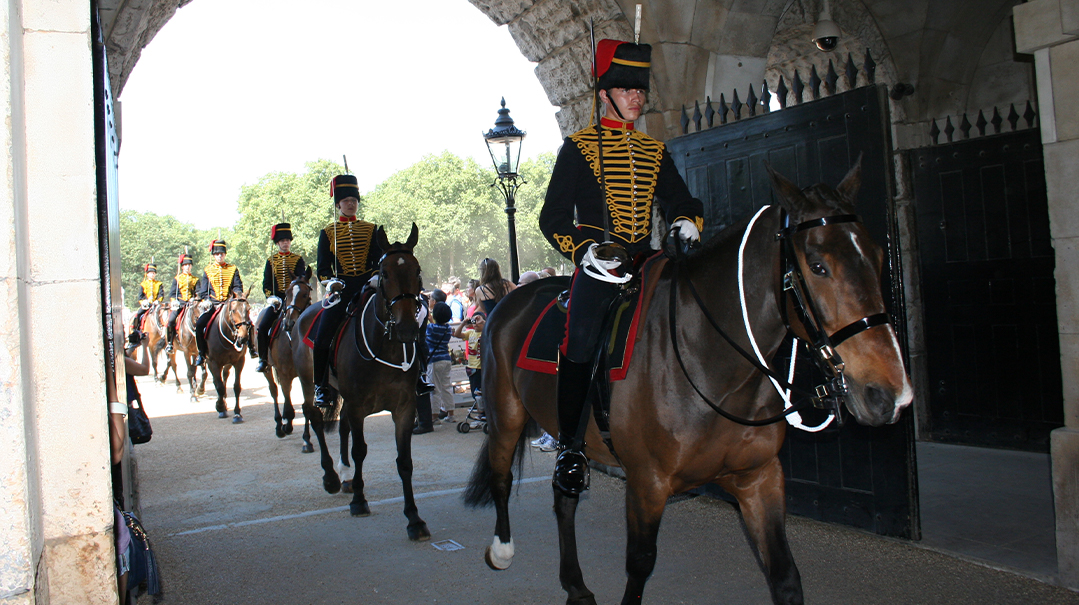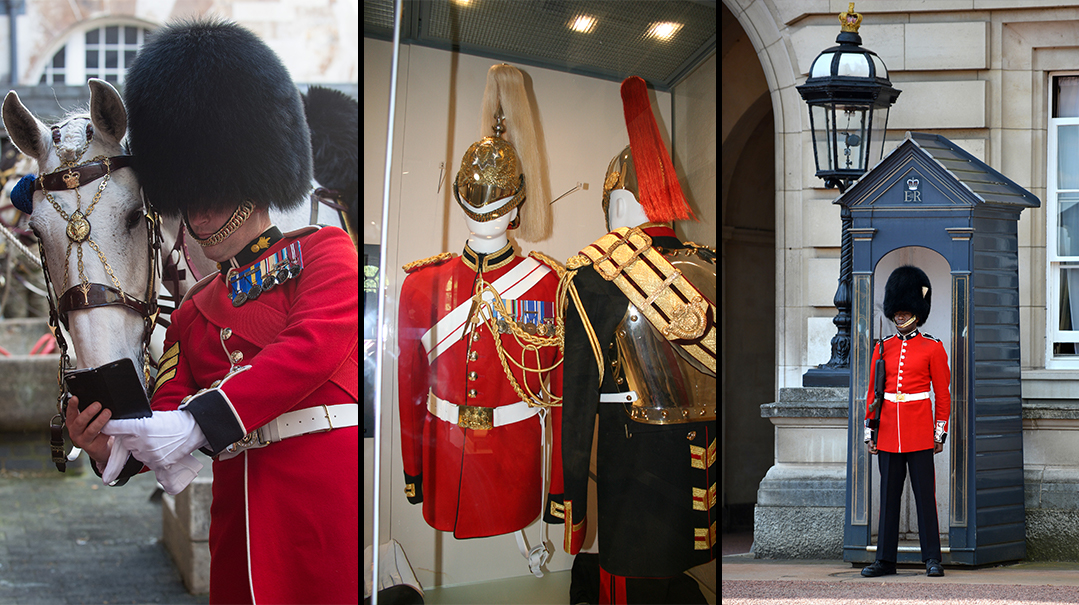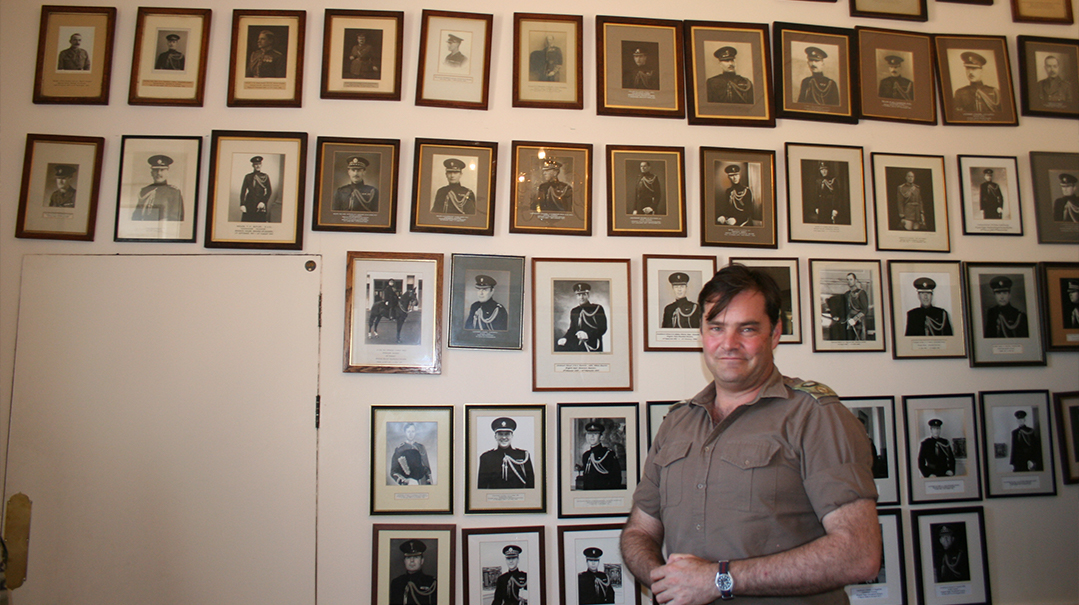On Guard!
| September 8, 2015
The British monarchy is famous for its majestic military ceremonies and splendidly outfitted guards. Mishpacha Jr. spoke to Lieutenant Colonel Simon Soskin, Brigade Major of the London Horse Guards, at their headquarters in Whitehall, a stone’s throw from Buckingham Palace
The iconic uniformed guards at the palace are a famous tourist attraction. Are they there for security or just for show?
Nowadays, they’re mostly ceremonial, but there’s also a security aspect. One of the ways Britain has been honoring its monarch since the 1600s is by protecting them and glorifying their reign with the provision of guards 24/7. A guard is placed outside Buckingham Palace, St. James Palace, and Windsor Palace — the royal family’s three London residences — as well as at the Tower of London, to guard the crown jewels.
Having been through real wars, the guards are highly skilled and very conscious of the security aspect.
So the royal guards are actual soldiers?
Indeed, and we often have to clarify this to citizens who think we’re maintaining this tradition purely for entertainment. A guard is an actual British soldier who serves in the army. Serving on royal guard duty is one of the perks, rather honors, given after around two years of army service. Many of the guards have fought in major operations overseas, such as the wars in Iraq and Afghanistan, and get a “break” doing ceremonial duties on their home turf.
Can anyone join the army?
Anyone between the ages of 16 and 25 can apply. They have to be fit and able-bodied and of decent intelligence proven with good GCSE grades (equivalent to American SATs) in high school. It used to be that applicants had to be of a minimum height, 5 foot 10 inches tall, but that no longer applies. Basic army training lasts one and a half years.
Why would someone want to join the army? What are the benefits?
A soldier’s salary is nice, and includes subsidised housing and food, which makes life a whole lot cheaper, especially if married with children, as many are. As a policy setter for the guards, I can say that doing guard duty is a huge honor. The greatest gift they can give their parents is a framed picture of themselves in their ceremonial uniform for the family mantelpiece.
Is guard duty as easy and exciting as it looks?
Not really. For a new guard, the first few weeks might be a novelty, especially with all the tourists vying for their picture and oohing and aahing over their every move, but after that, it can get pretty boring. The training especially is very tough. They go through 14 weeks of training learning how to do the precise drill movements of walking, standing, and marching, as well as horse-riding lessons. This is followed by five weeks of kit riding — learning to ride while wearing their full uniform kit, including cuirasses [a piece of armor covering the body from neck to waist, front and back], helmets, boots, etc.

It must be hard to ride a horse with all the gear.
Horse-riding lessons for cavalry (horse soldiers) is very different from regular horse riding. Firstly, the huge thigh-high boots make it hard to direct a horse the standard way, which is with one’s legs. Also, riders carrying the huge silver kettle drums learn how to ride with foot reins, because regular head reins can get in the way of their drums. It takes six months to train the horses in the unique method.
Besides this honorable position as royal guard, is serving in the army all about fighting and wars?
Not quite. There are some 200 roles in the army, available to suit different interests, from chef to driver to electrical engineer to tailor.
A tailor for the army?
Yes. Each soldier has several different uniforms and they have to be individually tailored and maintained to the highest standard. The tailors fit and mend the ceremonial uniforms from the plumes, hats, and medals to the standard khaki camouflage war uniform. Then there’s a Master Tailor who attends exclusively to uniform for the spring season, the ceremonial season, to check that everything fits impeccably.
Does that mean they have cleaners for their uniform too?
No. The guards have to care for their own uniforms — which we call their personal kit — a painstaking hand-washing process that can take around ten hours. For example, the thigh-high patent boots (called jackboots) are cleaned by soaking hot beeswax into the leather and then lathering on layers of polish, a process that takes hours. The guards become such proficient homemakers; the joke goes that a guard won’t let his wife iron his shirt, because no one could do it better than he can.
One of the uniforms has brass accessories that include a helmet, sword, and cuirass (a shield against swords — important protection in the olden days). These are painstakingly polished. It takes about an hour to clean them using brass polish and chalk brushes.
And not only do the guards have to look their finest; so do their horses. The guards have to groom them and clean their horse kit (to polish the bridle and leather saddle, to whiten their legs with white chalk, to oil the metal hooves, etc.), which can take around six hours till all shine to perfection.
Everything about this job is an honor and the guards understand that. To put out a flawless parade, hours of careful preparation are invested. The guards could work through the night to get themselves ready for a major ceremony.
Are they inspected before going out to face London’s millions of tourists?
Every day the commanding officer inspects the guards before they go out on duty, down to every brass pin. The guards graded most immaculate are rewarded with day duty mounted on a horse at a sentry box.
So there’s no getting away with sloppiness.
Not at all. There is an additional daily display called the “four o’clock inspection” parade, a tradition that actually started out as a punishment from Queen Victoria over a century ago. In 1894, she found an entire team of guards lazing about half drunk while on duty. Furious, she said they would be inspected every day at 4 p.m. for the next 100 years to avoid a repeat of that negligence. The current queen got used to the inspection tradition and ordered it to continue even after the 100 years passed.

The ceremonies must involve major preparations.
Indeed. Major ceremonies even have rehearsal parades, and the public knows about them and comes to watch them to avoid the crowds on the real day. The State Opening of Parliament, our biggest parade, boasts 1,400 guards and the second biggest, Trooping the Color (the Queen’s birthday parade, which funnily enough doesn’t take place on her birthday!) comprises 1,000 guards. We also have processions in honor of visits to the Queen by heads of state.
The daily parade, the Changing of the Guard, involves 100 guards — as 50 overnight guards change shifts with 50 incoming guards.
Where are rehearsals for the major parades held?
(Pointing outside our first-floor window) Actually, in the courtyard right below us, called St. James Park. His Highness Prince Charles, heir to the throne, and other members of the royal family, sit in this room, at this very window, and observe the rehearsals, giving it their approval of perfection… or disapproval.
(I express my surprise at sitting in the same room as the royal family does regularly. I have never met a monarch, but this is close enough. Hey, Jr. readers, looks like we’re in good company!)
What else goes on in this room, if I may ask?
The table we are sitting at is where Hitler [yemach shemo] infamously fooled British prime minister Neville Chamberlain into believing, in 1938, that he was not going to war, when soon after he invaded Poland and World War II broke out.
(Hearing who sat there, I move my chair a few inches back.) The high-ceilinged wall behind Lt. Col. Soskin’s seat holds rows and rows of stern-looking, black-and-white portraits. Who are they?
They are previous brigade majors, like myself. Before every difficult decision, I sweep my eyes over the wall and think to myself, What would they have done in my position?

Lieutenant Colonel Simon Soskin
The iconic uniforms have been around for centuries. Can you tell me any interesting tidbits about their history?
Today’s uniforms are the same design as the uniforms worn for over two centuries, with small adjustments over the years. They were once thick enough to be stab-proof, but that was for olden-day swords and spears.
The black fur bearskin hats are not as ancient. The British Army only started using them after the Napoleonic War in 1850, when their soldiers took the hats off French soldiers they killed, as trophies. The hats were then worn on the battlefield to protect against spear hits, and because it made the soldiers look taller and more intimidating. Today bearskins are purely ceremonial.
Different troops wear different uniforms. The red plume of hair on some helmets are from the hair of a female yak. The white plume is currently made of polyester, but it used to be made from whale’s teeth, which, when broken down, turn to hair.
Is it very stuffy in that uniform?
Yes. Considering they were once stab-proof, they’re certainly quite thick and hot. It can get very uncomfortable. It’s almost hard to move around with the uniform, which is why guards need help to get into their uniform — it can take a good half hour to get fully dressed. Once dressed, they then have to be helped onto their horses. After four hours, the end of a parade is a huge relief for both rider and horse; don’t forget the horse is carrying his own ceremonial attire plus the guard’s, a combined weight of 62 lbs (28 kg).
Is it warm enough for the winter?
In winter, the guards wear a gray military overcoat.
Come rain or shine, the guards stand like statues. How do they manage that?
A guard is on duty for 24 hours. During that time, he will have two hours on guard duty and then four hours off. To avoid restlessness, and to ward off cold, every ten minutes a guard will “come alive,” sloping his arms out and marching across his post, normally about 20 steps in total. After repeating this four or five times, the guard then gets back into position and “freezes” again.
Other than that, are they allowed to move at all?
The legend is that they may not smile or laugh and indeed, unless they can’t control themselves, they are to stand as still as possible. The guard rule states: “You may not eat, sleep, smoke, stand easy, sit, or lie down during your tour of duty.”
Tourists often try to make the royal guards laugh or move, by either tickling them, making jokes, mocking or even frightening them, so they can then show off the encounter on their cameras. How do guards handle these annoying tourists?
Their job is to protect Her Majesty the Queen. If tourists, like a group of teenagers, get rowdy and troublesome, the guard must protect himself and he will shout at the troublemakers to move back. But if it’s a good-natured young kid or an elderly person who means well, the guards are human after all and will display sensitivity and possibly even break into a smile.
There have been cases of foolish tourists getting violent or threatening to hurt the guard, just to secure a good shot or film of himself doing so. When that happens, the guard is entitled to protect himself, which he will start by cautioning the troublemaker.
How can he caution the troublemaker while standing still?
The first way they do this is with a crash of his heavy boot against the concrete ground, usually together with a shout of “Stand back from the guard!” If the person persists, the guard repeats the above but also moves his weapon, hands sloped ahead of him to keep it ceremonial. The final warning is pointing the weapon at the person — and the weapons are live and loaded so a tourist will not take further chances. This is considered the final warning. The next step would be for the guard to either detain the person or seek assistance.
But recently, due to increased incidents of tourists taunting guards, many guards now stand behind a railing.
Thank you for your time. It was an honor speaking to you!
(Originally featured in Junior, Issue 576)
Oops! We could not locate your form.





